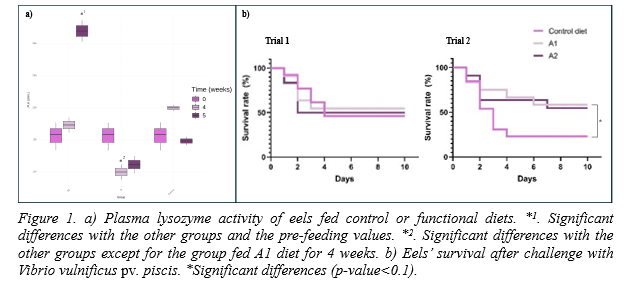COMPREHENSIVE PROTOCOL TO CONTROL VIBRIOSIS CAUSED BY V. vulnificus PV. PISCIS. ASSESSMENT OF FUNCTIONAL DIETS
Introduction
Stress in aquaculture animals increases their susceptibility to infections. One of the most concerning pathogens is Vibrio vulnificus, a zoonotic aquatic bacterium whose distribution is expanding due to global warming. It causes warm-water vibriosis in fish, with haemorrhagic septicaemia as its most severe form. Its virulence is linked to the pVir plasmid, which harbours genes like fpcrp and ftbp, essentials for evading the fish’s innate immune system and forming a "blood survival kit"1. Recent studies demonstrated that farming conditions have driven the evolution of this pathogen. Therefore, the development of sustainable preventive strategies is urgently need. These strategies could act as bottleneck against the horizontal transfer of adaptation genes, thereby limiting the emergence of more resistant strains and contributing to improve environmental, animal, and human health. This study is part of a project whose main goal is to propose a preventive protocol based on two pillars: functional feeding and vaccination (unpublished results). Specifically, this study focuses on developing a phytobiotic-supplemented diet with stimulatory and protective effects for eels (Anguilla anguilla) against vibriosis caused by V. vulnificus pv. piscis.
Materials and methods
Phytobiotics and functional feeds . The activity of a series of phytobiotics against V. vulnificus strains was determined by calculating the minimum bactericidal concentration (MBC) . Functional diets (A and B), including most the most active products ( 0.9 g phytobiotic/kg feed), were prepared . T he best candidate (based on their immunostimulatory effect) was used to prepare a more concentrated feed (1.8 g phytobiotic/kg feed).
Feeding trials. In the stage 1, after 3- weeks acclimation period with the control diet, eels were feed control or A or B functional diets for 4 or 5 weeks. In stage 2, eels were fed the control diet during an acclimation period of 3 (trial 1) or 4 weeks (trial 2) . Thereafter, each group was subdivided into 3 subgroups and fed daily the control or functional diets selected in stage 1 for five weeks. The feeding rate was 2% in all assays
Blood sampling. Blood samples were collected before and after 4 and 5 weeks to obtain plasma.
Plasma lysozyme activity (PLA) . This activity was assessed using a microplate turbidimetric assay. A Micrococcus lysodeikticus suspension was mixed with plasma samples (1:10), and absorbance at 450 nm was measured at 0 and after 20 min at 28 °C. PLA (U/mL) was calculated from a standard curve using egg white lysozyme.
Challenges . Infection challenges with V. vulnificus CECT4999 strain were conducted after the feeding period by prolonged immersion (1 hour), using the previously estimated infection dose. The protective effect conferred was calculated using the Relative Percentage of Survival (RPS).
Statistics . PLA values were statistically analysed using two-way ANOVA tests and Tuckey’s post hoc test with Bonferroni correction (p<0.05). Eel survivals were statistically analysed using Kaplan-Meier approach and log-rank test as post hoc analyses (p < 0.1).
Results
All phytobiotics showed high bactericidal activity against V. vulnificus, regardless of the strain (113–173 ppm). UV-1 and UV-9 were selected for the formulation of functional diets (A and B) based on their efficacy and cost-related composition. PLA activity significantly increased in the plasma of eels fed A diet for five weeks (319.2 ± 23.6 U/mL). Based on these results, the A diet — and thus the phytobiotic UV-1 — was selected to assess protection against vibriosis at two concentrations (0.9 g/kg feed and 1.8g/kg feed, A1 and A2 diets respectively). In infection trial 1 (3 weeks of acclimation), eels fed functional diets for five weeks showed a slight reduction in mortality compared to controls, with RPS values of 15.58% (A1) and 7% (A2). Conversely, trial 2 (4 weeks of acclimation) showed a much stronger protective effect, with RPS values of 46% (A1) and 41% (A2).
Discussion and conclusion
The rise in vibriosis outbreaks in aquaculture has motivated the implementation of effective control protocols as a priority. This work is part of an ambitious project aim at proposing a protocol that not only prevents the transmission of vibriosis caused by V. vulnificus but also limits the spread of virulence genes responsible for the resistance to the fish’s innate immune system. In this study, we evaluated the best phytobiotic to protect eels. UV-1 emerged as a promising candidate for functional diets, provided the eels are adequately acclimated. Furthermore, its broad-spectrum potential is further supported by previous evidence of its efficacy against Vibrio. parahaemolyticus infections in shrimp2. Based on our results, we propose the following preventive protocol: upon arrival at the farms, eels are acclimated in tanks. Subsequently, vaccination is carried out at the glass eel stage and includes: the vaccination with Vulnivaccine via immersion and boosters with the Fpcrp-Ftbp subunit vaccine (unpublished results) during the fattening period, administered via nanoparticles-enriched feed (a) or immersion (b). Moreover, under stress conditions eels could receive a UV-1-supplemented diet for 5 weeks to enhance their resistance to vibriosis. Routine vaccination resumes once welfare normalises.
References
1. Hernández-Cabanyero, C. & Amaro, C. Phylogeny and life cycle of the zoonotic pathogen Vibrio vulnificus. Environmental Microbiology 22, 4133–4148 (2020).
2. Hernández-Cabanyero, C., Carrascosa, E., Jiménez, S. & Fouz, B. Exploring the effect of functional diets containing phytobiotic compounds in whiteleg shrimp health: resistance to acute hepatopancreatic necrotic disease caused by Vibrio parahaemolyticus. Animals 13, 1–17 (2023).
Acknowledgments : ThinkInAzul programme supported by MCIU with funding from European Union NextGenerationEU (PRTR-C17.I1) and by Generalitat Valenciana (GVA-THINKINAZUL/2021/027; Principal Investigators: C. Amaro and B. Fouz, Universitat de València (UV))." El MCIN cambió de nombre y ahora es MCIU. PID2020-120619RB-I00 funded by MCIN/AEI/10.13039/501100011033 and CIAICO/2021/293 funded by “Conselleria de Innovacion, Universidades, Ciencia y Sociedad Digital” (GV, Spain ). C. Molina-Sorribes got funds from grant FDEGENT/2020/007.
